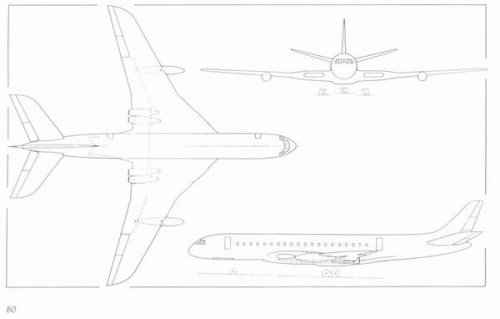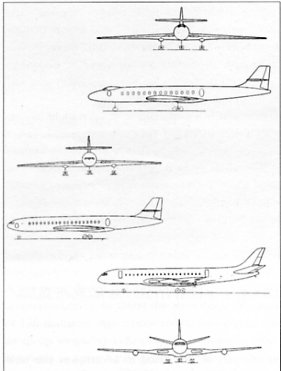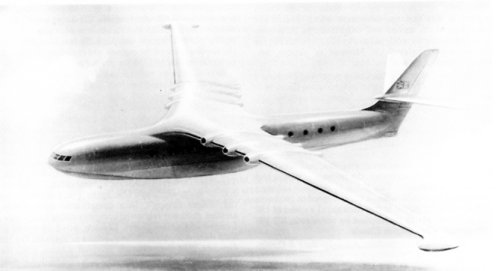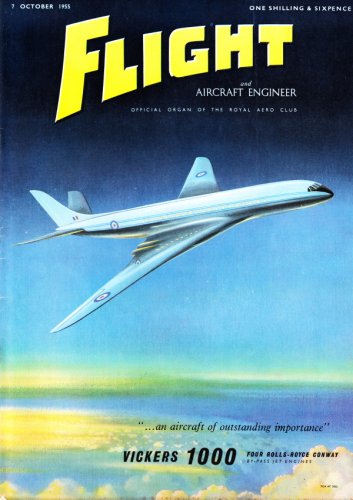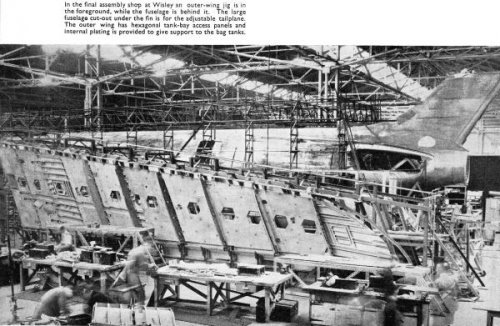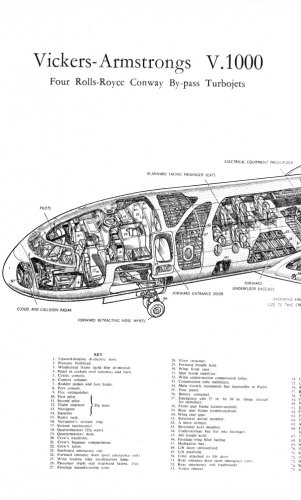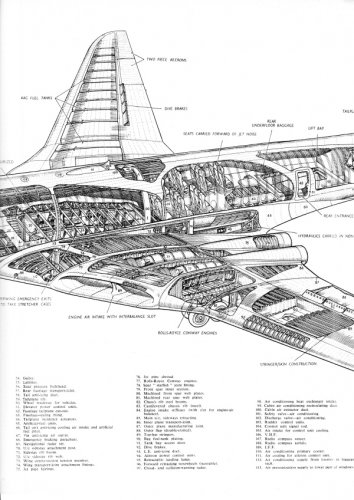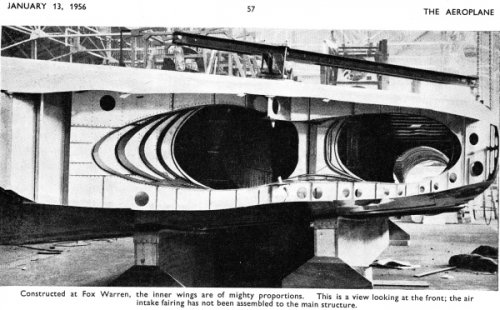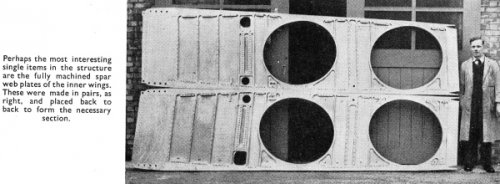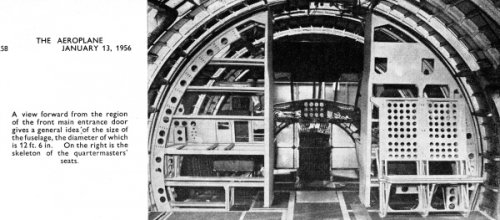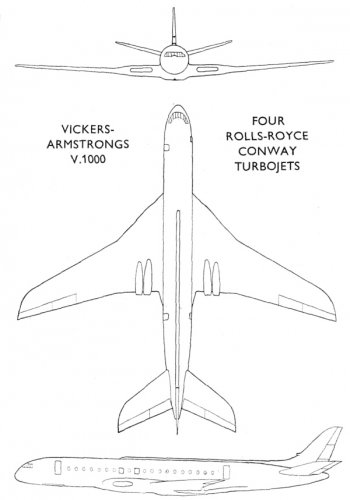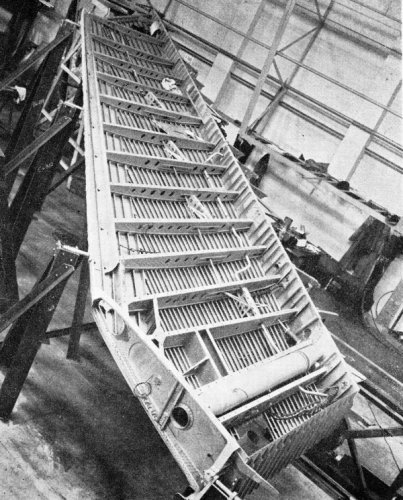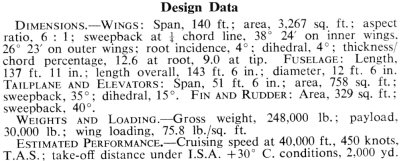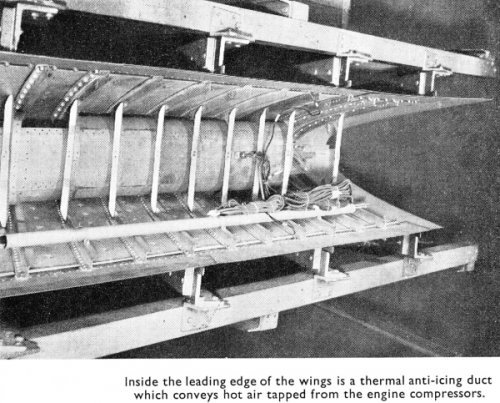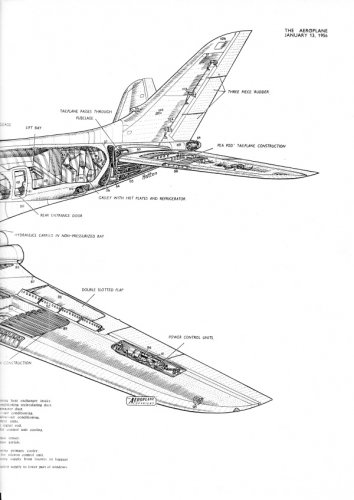You are using an out of date browser. It may not display this or other websites correctly.
You should upgrade or use an alternative browser.
You should upgrade or use an alternative browser.
Vickers VC-7 and V-1000
- Thread starter Archibald
- Start date
- Joined
- 11 March 2006
- Messages
- 8,625
- Reaction score
- 3,805
Attached a 3-view of the VC.7 (from D.Wood "Project Cancelled"). As is told inh this book,
one of the reasons for the failing of this project, laid in th fact, that the civil VC.7 was seen
as a derivative of the military transport, which was designed with several features not necessary
for a civil aircraft of this class, e.g. short field performance. Basic data given for the V.1000
are : 42,67m span, 303,5sqm wing area, 42,06m lenght and 3,81m fuselage diameter. After
several design changes weight had risen to 112.493kg, so an up-rating of the Conway engines
was necessary. And with the cancellation by the RAF the type finally was doomed, as there
wasn't seen enough export potential.
one of the reasons for the failing of this project, laid in th fact, that the civil VC.7 was seen
as a derivative of the military transport, which was designed with several features not necessary
for a civil aircraft of this class, e.g. short field performance. Basic data given for the V.1000
are : 42,67m span, 303,5sqm wing area, 42,06m lenght and 3,81m fuselage diameter. After
several design changes weight had risen to 112.493kg, so an up-rating of the Conway engines
was necessary. And with the cancellation by the RAF the type finally was doomed, as there
wasn't seen enough export potential.
Attachments
Sentinel Chicken
American 71 Heavy, contact departure 126.47
Eric Morgan's Aerofax publication Vickers Valiant: The First of the V-Bombers actually devotes a section to the VC-7 and V-1000 that's quite interesting.
- Joined
- 22 January 2006
- Messages
- 4,213
- Reaction score
- 2,010
Jemiba was faster than me 
But I still can add some more info
Archi you should also consider this book for Christmas: Stuck on the Drawing Board. Unbuilt British Commercial Aircraft Since 1945 by Richard Payne. Ed Tempus. ISBN 0 7524 3172 2.
It is a treasure!
V1000 was ordered in 1951 to replace the HP Hastings. It would give logistical assistance to the V-bomber force deployements anywhere in the World.
Contenders:
a) de Havilland stretched Comet
b) HP Victor double-bubble fuselage derivative
c) Avro Vulcan derivative
d) Short Sperrin derivative
e) Vickers Valiant derivative
f) Bristol Britannia forward variant
g) Saunders Roe Duchess forward variant
A commercial variant for BOAC was also envisaged, the VC7. It was proposed as a Comet II replacement.
The best proposals were Vickers and de Havilland and Vickers was declared winner. Production order was placed in 1954. The design was revised to compete for the Comet 3 replacement against the Avro Atlantic, Bristol 187 and HP 97 (Pacific). This forced the RAF to accept a bigger aircraft than originally accepted. By 1955, it was found that all-up weight had increased and BOAC began to cool towards the VC7 advocating for new Britannia and Comet developments while puting forward designs studies for new aircraft. The VC7 could have been in airline service by 1959-60.
The final came when the military order was cancelled and on 11, November 1955 the program was also cancelled. Vickers had been trying to interest BOAC with different engine options and design variants with underwing poded engine layout but BOAC ordered the 707 and British Airliner development lost its way.
But I still can add some more info
Archi you should also consider this book for Christmas: Stuck on the Drawing Board. Unbuilt British Commercial Aircraft Since 1945 by Richard Payne. Ed Tempus. ISBN 0 7524 3172 2.
It is a treasure!
V1000 was ordered in 1951 to replace the HP Hastings. It would give logistical assistance to the V-bomber force deployements anywhere in the World.
Contenders:
a) de Havilland stretched Comet
b) HP Victor double-bubble fuselage derivative
c) Avro Vulcan derivative
d) Short Sperrin derivative
e) Vickers Valiant derivative
f) Bristol Britannia forward variant
g) Saunders Roe Duchess forward variant
A commercial variant for BOAC was also envisaged, the VC7. It was proposed as a Comet II replacement.
The best proposals were Vickers and de Havilland and Vickers was declared winner. Production order was placed in 1954. The design was revised to compete for the Comet 3 replacement against the Avro Atlantic, Bristol 187 and HP 97 (Pacific). This forced the RAF to accept a bigger aircraft than originally accepted. By 1955, it was found that all-up weight had increased and BOAC began to cool towards the VC7 advocating for new Britannia and Comet developments while puting forward designs studies for new aircraft. The VC7 could have been in airline service by 1959-60.
The final came when the military order was cancelled and on 11, November 1955 the program was also cancelled. Vickers had been trying to interest BOAC with different engine options and design variants with underwing poded engine layout but BOAC ordered the 707 and British Airliner development lost its way.
Attachments
What is interesting in this competition is it merge all the heavies aircrafts developed in GB in the early 50's... Bombers derivatives, turboprop and jet powered airliners...
What was exactly the SARO Duchess ? a land based variant of the Princess huge flying boat ?
Very interesting!!!
What was exactly the SARO Duchess ? a land based variant of the Princess huge flying boat ?
Very interesting!!!
- Joined
- 22 January 2006
- Messages
- 4,213
- Reaction score
- 2,010
The Duchess was this beauty :
(From Sea to Air. The Heritage of Sam Saunders. By Tagg & Wheeler. ISBN 0-9509739-3-9.
A masterpiece! 316 pages full of unbuilt projects)
Britannia and Duchess were discarded early in the selection process.
Cheers
Antonio
(From Sea to Air. The Heritage of Sam Saunders. By Tagg & Wheeler. ISBN 0-9509739-3-9.
A masterpiece! 316 pages full of unbuilt projects)
Britannia and Duchess were discarded early in the selection process.
Cheers
Antonio
Attachments
- Joined
- 22 January 2006
- Messages
- 4,213
- Reaction score
- 2,010
This plane is a flyign boat no ? a jet powered ariliner flying boat
That's it, for 40 passengers.
- Joined
- 22 April 2012
- Messages
- 2,258
- Reaction score
- 2,308
Much is made here of the role that was to be undertaken by the Vickers V.1000 in support of the V-Force with Bomber command. Obviously the type would have fulfilled a tanker role and generic logistics support for the force but I have been unable to find any specific details on the oft-mentioned Electronic Warfare (EW) role of the aircraft. Was this to be surveillance or actual jamming? Were any specific systems mandated? Would there have been dedicated EW aircraft or would they have been the same aircraft used for the tanker and logisitcs role.
Finally how many V.1000's were planned/hoped for for the RAF? Only 23 Brittaninas were procured instead although they did not fulfill the tanker role?
Thank you in advance sealordlawrence.
Finally how many V.1000's were planned/hoped for for the RAF? Only 23 Brittaninas were procured instead although they did not fulfill the tanker role?
Thank you in advance sealordlawrence.
danielgrimes
ACCESS: Confidential
- Joined
- 8 October 2007
- Messages
- 57
- Reaction score
- 11
Ministry of Supply specification C.123D was placed in January 1953 and for 6 prototype and pre production aircraft (the number 6 was only revealed 18 months later). The aircraft was de-scoped June 1955 to operate at lower speed and altitude than the Valiant. Assuming a jamming role would require the aircraft to fly with the Valiants, it must have been muted before mid 1955.
Not much help sorry, but maybe will point you in the right direction?
Not much help sorry, but maybe will point you in the right direction?
- Joined
- 22 April 2012
- Messages
- 2,258
- Reaction score
- 2,308
Daniel thank you,
You have actually confirmed my own feelings on this which is that the EW plans were probably shelved quite early on. Once EW systems started to be integrated into Victors and Vulcans there was likely little need for V.1000's to support them. They would therefore have likely been little more than tankers and logistics aircraft. I would still love to know where this reference comes from though!
You have actually confirmed my own feelings on this which is that the EW plans were probably shelved quite early on. Once EW systems started to be integrated into Victors and Vulcans there was likely little need for V.1000's to support them. They would therefore have likely been little more than tankers and logistics aircraft. I would still love to know where this reference comes from though!
sealordlawrence said:Daniel thank you,
You have actually confirmed my own feelings on this which is that the EW plans were probably shelved quite early on. Once EW systems started to be integrated into Victors and Vulcans there was likely little need for V.1000's to support them. They would therefore have likely been little more than tankers and logistics aircraft. I would still love to know where this reference comes from though!
Hi,
A thought the original intention I suspect was not just a simple “jamming” platform. What else did Bomber Command do in the Second War?
- Joined
- 20 January 2007
- Messages
- 953
- Reaction score
- 1,143
V.1000 endured from 3/53-11/55. First Valiant order, for 25, was 9/2/51, with further batches to 104 in 1952. UK lost its $ subsidies at Korean Armistice and chose to remove its 80,000 conscripts from the Canal Zone by late-1954, greatly reducing the Air Transport Task. By then new Defence Minister Macmillan was forming his view that “It is defence (spend) that has broken our backs. We also know that we get no defence from (it)” and whetted his axe, firstly on Swift F.1-3. As we must now pay for all our kit ourselves, conscription and RAuxAF were to go; Medium Bomber Force would be instead of, not as well as Canberra Light Bomber Force; Vulcan/Victor B.1 would be instead of, not as well as Valiant B.1, due in part to AWRE's inability to produce "stores" apace.
The wonder is not that V.1000 was cancelled, but that it lingered to 11/55. V-A, reading the runes, invented EW/PR/IFR variants, but all those roles went to as-yet-undelivered, but uncancellable US-funded Valiants. 199 Sqdn., later 18 Sqdn. had 7 EW Valiants as "spoofers" within the bomber/decoy stream. Signals "surveillance" was by 192 Sqdn. Washington (to 2/58),151 Sqdn. Lincoln (to 1963), 51 Sqdn. Canberra B.6(Mod), Comet C.2R.
The wonder is not that V.1000 was cancelled, but that it lingered to 11/55. V-A, reading the runes, invented EW/PR/IFR variants, but all those roles went to as-yet-undelivered, but uncancellable US-funded Valiants. 199 Sqdn., later 18 Sqdn. had 7 EW Valiants as "spoofers" within the bomber/decoy stream. Signals "surveillance" was by 192 Sqdn. Washington (to 2/58),151 Sqdn. Lincoln (to 1963), 51 Sqdn. Canberra B.6(Mod), Comet C.2R.
- Joined
- 22 April 2012
- Messages
- 2,258
- Reaction score
- 2,308
Ken, I agree entirely, I merely seek to establish the exact intended role for the type. 
It is very apparent the immediate UK strategy was a typically expensive one, strategic nuclear deterrance, a Navy able to engage Soviet naval bases and massed armoured formations supported by army nuclear weapons. Simultaneous with the reduction in overseas commitments we see a withdrawal from the European ones too. The RN retreats to the GIUK line and the RAF slowly gives up its strategic role. Economic reality is a hard one.
It is very apparent the immediate UK strategy was a typically expensive one, strategic nuclear deterrance, a Navy able to engage Soviet naval bases and massed armoured formations supported by army nuclear weapons. Simultaneous with the reduction in overseas commitments we see a withdrawal from the European ones too. The RN retreats to the GIUK line and the RAF slowly gives up its strategic role. Economic reality is a hard one.
sealordlawrence said:Ken, I agree entirely, I merely seek to establish the exact intended role for the type.
It is very apparent the immediate UK strategy was a typically expensive one, strategic nuclear deterrance, a Navy able to engage Soviet naval bases and massed armoured formations supported by army nuclear weapons. Simultaneous with the reduction in overseas commitments we see a withdrawal from the European ones too. The RN retreats to the GIUK line and the RAF slowly gives up its strategic role. Economic reality is a hard one.
Hi Sealordlawrence,
At what period of time? It changed.
Note it was the Handley Page which was the First choice for the RAF, best performance!
Two variants then Three variants for certain plus proposed enlarged fuselage version to carry the UK LRBM.
Tanker/Transport / Radio Warfare
Transport as support aircraft for Empire Deployment of Canberra force to Singapore.
The Radio Warfare version was to be flown in support of the main Bomber Force with similar performance capability. Any alleged shortcomings Contrived to justify cancellation
Role split to separate Tanker and Transport roles but all aircraft types to retain receiver capability,
Transport has priority and receives initial order for six aircraft, second batch of six at cheaper rate if order confirmed... Very much cheaper than Boeing KC135 despite advantage of huge order in fact even the Canadair aircraft was consider as a better choice for USAF transport role but politics intervened
It was a Government inspired nonsense that the V1000 was unaffordable.
For given task this was internally admitted it was the cheaper option.
It is also admitted that it could not be faulted on technical grounds.
It appears that its field performance was superior to its eventual replacement the Britannia and about 6,000ft shorter than the Boeing KC 135 in the worst possible case.
In fact similar to the latest American piston job at the time.
It could have used just about any Civil International Airport of the period and World Wide the projected B707 only two. The Americans did not build long runways for fun.
V1000 had a 50% greater capacity and ceiling than the equivalent Boeing and needed only half the runway and more Stealthy.
Objectively it should have replaced the Boeing and been produced like the Canberra under license, possibly by Boeing in the States. At that time there was a congressman/ senator from California? Who is stated as saying what can we do about the British? Aeroplane or Flight can not remember which. Can anyone Help please?
But it was our own people who put the Knife in!
- Joined
- 22 April 2012
- Messages
- 2,258
- Reaction score
- 2,308
V.1000 and HP.111/Belfast are of different generations although the argument could be made that the latter was a product of the cancellation of the latter in that case one can not avoid the obvious observation that the latter was also effectively cancelled.
With the V-Force planning having already been reduced from 240 to 180 (also never achieved) the affordability argument is very obvious and it should be noted that the V.1000 was not really replaced as a programme, the Brittania simply being a low cost expediant.
What ever the arguments in favour of the aircraft technically the fact is that it lacked BOAC (commercial) support and MoD budget funding effectively making it unviable as a business product.
With the V-Force planning having already been reduced from 240 to 180 (also never achieved) the affordability argument is very obvious and it should be noted that the V.1000 was not really replaced as a programme, the Brittania simply being a low cost expediant.
What ever the arguments in favour of the aircraft technically the fact is that it lacked BOAC (commercial) support and MoD budget funding effectively making it unviable as a business product.
sealordlawrence said:V.1000 and HP.111/Belfast are of different generations although the argument could be made that the latter was a product of the cancellation of the latter in that case one can not avoid the obvious observation that the latter was also effectively cancelled.
With the V-Force planning having already been reduced from 240 to 180 (also never achieved) the affordability argument is very obvious and it should be noted that the V.1000 was not really replaced as a programme, the Brittania simply being a low cost expediant.
What ever the arguments in favour of the aircraft technically the fact is that it lacked BOAC (commercial) support and MoD budget funding effectively making it unviable as a business product.
Hi sealordlawrence,
Yes agreed the HP 111 was later and again the RAF choice, but it was the HP 97 in 1952 but BOAC would have nothing to do with it.
They started looking at the logistics of the RAF Space Programme about 1954 there is a reference in RAF Flying Review middle sixties article on the Belfast or VC10? to the earlier Vickers jet (V1000 widebody) carrying the LRBM.
The Aircraft costing is based on a review in official documents (now held at Kew) put together to justify the cancellation and the fact that the V1000 was marginally more expensive you needed fewer aircraft for a given task and thereby was the cheaper. Actually thinking about it now with the Britannia mods the V1000 was cheaper still.
- Joined
- 22 April 2012
- Messages
- 2,258
- Reaction score
- 2,308
I find it impossible to believe that the far more complicated V.1000 would work out cheaper than the already designed and built Brittania and the modded Valiants.
I agree that had the V.1000 survivied it is likely that it may have been evolved to carry the IRBM.
I agree that had the V.1000 survivied it is likely that it may have been evolved to carry the IRBM.
sealordlawrence said:I find it impossible to believe that the far more complicated V.1000 would work out cheaper than the already designed and built Brittania and the modded Valiants.
I agree that had the V.1000 survivied it is likely that it may have been evolved to carry the IRBM.
Hi sealordlawrence,
In simple terms BOAC could have brought six months later about 15 VC.7 and 15 V.1000 type 1001 instead of just 15 of the much inferior Boeing B.707 or in real terms an even greater number allowing for UK tax clawback.
From memory Britannia about £1.1 million (cost with OUT mods), V.1000 less than £ 1.5 million, ( reduced to about £1.2 million when another six are purchased, Boeing 707 £ 3 million
.
- Joined
- 20 January 2007
- Messages
- 953
- Reaction score
- 1,143
"BOAC could have bought...". How so? (I don't have to hand reported BOAC 707-400 unit price, all-up, inc. engines/UK kit, but: )Boeing-sponsored hagiography, RJ Serling, Legend & Legacy, St.Martin's Press, 1992,P.137: 707-120 (10/55) unit price for 20 to Launch Customer PAA "came closer to $5n.....Douglas' (DC-8/30) $3.9Mn...(P.138) AA's for 32, $5.5Mn." (excl. JT3C, leased from Pratt) (then £1=$2.8). All those numbers had R&D as Company expense, not Users', or taxpayers' (though the AI Case v. Boeing in WTO is that NASA/DoD "disguised" money helps). V-A/RR were doing so well on Viscount in 1954/55 because (much) R&D cost was dumped on us, not on Customers. Neither Geo.Edwards, nor RR nor MoS had any idea of VC7/civil Conway R&D expense, but knew that V-A/RR would not have paid (all of) it. Maudling cancelled V.1000 (he had never invested our money in VC7) because "I could not find a customer. BOAC did not want it and RAF could not afford it” Memoirs,Sidgwick,78,P62. It is meaningless to compare a product which sold 1,010 with a paper exercise which could not attract its Board's confidence to persevere with the in-progress prototype. Vickers, of all people, had the resources to do so...if they believed in its marketability. But they did not. So, let sleeping schemes lie. This endless moaning about cancelled projects rests on the presumption that humble folk on £10 p.week/higher earners on >75% tax rate, should enjoy doing what industry would not - paying. Why? One reason HP died was Sir Fred's outlook on life: “The role of the State is to provide facilities for fattening the goose which will lay the golden eggs” Sir Fred., Flight,15/1/60. Nay, nay, thrice nay.
- Joined
- 22 April 2012
- Messages
- 2,258
- Reaction score
- 2,308
There is another issue here regarding the wrting of history.
British post war naval history has been extremely well written by a number of exceptional authors, most notably Eric Grove in Vanguard to Trident but also by others who have successfully linked the political to the military and the industrial. In the case of aviation history this has not been the case to the same extent. There has been much focus on the technical aspects of aircraft and not enough on the environment that surrounded them and this has helped to fuel the 'stab in the back' consensus that stalks these forums.
British post war naval history has been extremely well written by a number of exceptional authors, most notably Eric Grove in Vanguard to Trident but also by others who have successfully linked the political to the military and the industrial. In the case of aviation history this has not been the case to the same extent. There has been much focus on the technical aspects of aircraft and not enough on the environment that surrounded them and this has helped to fuel the 'stab in the back' consensus that stalks these forums.
sealordlawrence said:There is another issue here regarding the wrting of history.
British post war naval history has been extremely well written by a number of exceptional authors, most notably Eric Grove in Vanguard to Trident but also by others who have successfully linked the political to the military and the industrial. In the case of aviation history this has not been the case to the same extent. There has been much focus on the technical aspects of aircraft and not enough on the environment that surrounded them and this has helped to fuel the 'stab in the back' consensus that stalks these forums.
Hi,
Agree with what you say about the issue of writing History actual re-writing History. I just want the most accurate view that we can get.
The figures are taken from original sources
FLIGHT, 2 November 1956 737
"The value of the order for the 15 Boeing 707s is approximately
£44m, including spare engines and overhaul spares. Of that total
some £9m represents the cost of die British engines, spare engines
and engine overhaul spares."
Ummmh thinks! I thought the Pound was stronger in 1956 but taking $2.8 that is about £100 million for Fifteen aircraft
The other approximate figures were lifted from the Government archived documents. But will get the exact figures from the archive on my next visit.
Who was the president of TCA who flew to UK to try and purchase the Vc7?
Maulding must have forgotten.
I guess Vickers would keep their mouth shut and toe the line to get the next Government contract, Vanguard.
- Joined
- 20 January 2007
- Messages
- 953
- Reaction score
- 1,143
(Flight: 1/6d {7.5p} in Oct.1955 when Valiant Captains earned £20 p.wk, say 60p/hr: 7.5 mins to buy it. Today, a Ft.Lt. at £35K, £700 p.wk, £17.50/hr, Flight Intnl. cover price is £2.95: 10 mins. to buy it, but it's better. So UK magazines have matched general inflation.)
V.1000 was chopped 3 weeks after that ad. BOAC first declined VC7 soon after. BEAC committed to 6 V.950 just about exactly then, 14 more in 1956; TCA, to 23 longer-range V.952 soon after. Scheming a Viscount Major had begun in 1953. Almost uniquely in post-War UK Aero, Vanguard was PV-funded in R&D. Vickers' Board presumably preferred the better risk:reward in the move from Viscount to Vanguard, over a move from Valiant to a BOAC-driven VC7. They may have been influenced by lack of yearning at RR to invest in a cannibal to their DC8/40 and 707-400 ambitions. Vickers knew of Lockheed/Allison's in-progress adaptation of L.188/501 from (to be P-3 Orion)/T56, but may have believed the Capital A/L V.745 coup would open US to V-A's Major. Spark may be right to infer Vickers declined to fund VC7 not because it would be also-ran to DC-8/707, but because they would only spend on one and chose the safer bet.
BOAC in 1955 had no experience of V-A responsiveness to Viscount Users; they knew how they had been served by Avro on Tudor, and HP on Hermes: badly. Yet BOAC in 1956 had Ministers' support, though molested in the House, to decline a Transatlantic VC7 Issue 2, or any-Comet, or any V-Craft variant, or the type launched with 25 for PAA from the fine stable of DC-4/DC-6. They chose Conway-707 from the expensive and slow B.377 team. Why such faith? In part, I suggest, because BOAC knew V-A's products were not built: they were sculpted. Apologists have Vanguard market failure as due to jets, but fine Viscount operators Ansett, Cathay Pacific, KLM and TAA all chose Electra, cheaper to operate than Vanguard. H.Wynn,History of RAF Transport Command: Forged in War,HMSO,96,P96: weight “would prevent (V.1000, so VC7) providing required payload/range.” BOAC did not believe in the quick, cheap fix of more Conway grunt. If V-A did, it was open to them to commit contractually to such a fix, money where mouth was. Boeing bid 707-400 fixed price with performance guarantees; V-A bid a brochure.
V.1000 was chopped 3 weeks after that ad. BOAC first declined VC7 soon after. BEAC committed to 6 V.950 just about exactly then, 14 more in 1956; TCA, to 23 longer-range V.952 soon after. Scheming a Viscount Major had begun in 1953. Almost uniquely in post-War UK Aero, Vanguard was PV-funded in R&D. Vickers' Board presumably preferred the better risk:reward in the move from Viscount to Vanguard, over a move from Valiant to a BOAC-driven VC7. They may have been influenced by lack of yearning at RR to invest in a cannibal to their DC8/40 and 707-400 ambitions. Vickers knew of Lockheed/Allison's in-progress adaptation of L.188/501 from (to be P-3 Orion)/T56, but may have believed the Capital A/L V.745 coup would open US to V-A's Major. Spark may be right to infer Vickers declined to fund VC7 not because it would be also-ran to DC-8/707, but because they would only spend on one and chose the safer bet.
BOAC in 1955 had no experience of V-A responsiveness to Viscount Users; they knew how they had been served by Avro on Tudor, and HP on Hermes: badly. Yet BOAC in 1956 had Ministers' support, though molested in the House, to decline a Transatlantic VC7 Issue 2, or any-Comet, or any V-Craft variant, or the type launched with 25 for PAA from the fine stable of DC-4/DC-6. They chose Conway-707 from the expensive and slow B.377 team. Why such faith? In part, I suggest, because BOAC knew V-A's products were not built: they were sculpted. Apologists have Vanguard market failure as due to jets, but fine Viscount operators Ansett, Cathay Pacific, KLM and TAA all chose Electra, cheaper to operate than Vanguard. H.Wynn,History of RAF Transport Command: Forged in War,HMSO,96,P96: weight “would prevent (V.1000, so VC7) providing required payload/range.” BOAC did not believe in the quick, cheap fix of more Conway grunt. If V-A did, it was open to them to commit contractually to such a fix, money where mouth was. Boeing bid 707-400 fixed price with performance guarantees; V-A bid a brochure.
alertken said:One reason HP died was Sir Fred's outlook on life: “The role of the State is to provide facilities for fattening the goose which will lay the golden eggs” Sir Fred., Flight,15/1/60. Nay, nay, thrice nay.
I would have thought the same could be said about any aviation company.........
Hi;
The drawings have detail I have not noticed before, The end view much more civilised, does not show the four open urinals and the four stalls shown in other drawings for the "trooper version"
From notes taken some years ago.
Bill Gunston gives a possible figure of 286,000 lb. that fits the case for maximum fuel load with a payload of sixteen and half tons.
An extra one thousand yard allowance had already been allowed for but was not required only a mere few hundred feet at most. The large wing was very efficient with a very advanced section and far superior to that chosen for the Boeing 707/KC135 allowing a huge payload range growth potential with an exceptionally high ceiling for the class of aircraft. The ceiling was important in the case of the Military or planned RCM/Radio warfare variant.
“The position now reached with this aircraft raises doubts as to the wisdom of trying to develop a strategic jet transport aircraft, with a large range and payload and cruising at a high speed, but expected to operate safely from fighter airfields in tropical conditions.”
“Bearing in mind the inconsistency in the take-off requirement, it appears that some concessions in some parts of OR.315 will be necessary.”
“It is clear from the Air Council record that the lateness of the aircraft was not considered in itself to be unacceptable if other wise the operational requirement were met”
Failure to meet an early in service date was the main excuse given publicly for cancellation. Secretly it was pointed out in a Ministerial briefing document that the early in service date could have only been met by placing a production tooling contract to run concurrently with the prototype contract and this was not done. It also indicated/stated that Treasury procrastination with funding was also responsible for an additional delay of a year or more. It was always understood from quite early on in the programmes development that the late fifties in service date was the realistic proposition that would have allowed a developed engine with a power rating that would have allowed the aircraft to fully meet or comfortably exceed all the original operational requirements. This date was generally understood and accepted that it posed no significant problem to the end user.
What rubbed salt in the wound was that soon after the cancellation a miracle happened it was found possible to develop the Conway for the Boeing and Douglas Aircraft up to and beyond what Vickers were asking for the VC7. Same engine in the type 1001 would have allowed the aircraft to fully meet O.R.315: The civil VC7, type 1002 and type1003 could have carried in excess of150 passengers across the Atlantic either on the direct London New York or Paris New York routes.
Desperate for an excuse
“……the best line to take would be that the delivery date of the aircraft had slipped back unacceptably. This line could not be disputed by the firm and it should carry conviction with the public”.
Exit Strategy, just in case the pooh hits the fan?
“The Minister of Supply gave his provisional opinion that he still did not accept that the Air Ministry Statement that the aircraft had failed to meet its’ operational requirement”
Note by the Ministry of Supply
“…..because the aircraft is not coming up to their expectations (though the extent, if any, to which the firm have failed in their design work to meet the specification is open to dispute.”
For the most part in reality it had exceeded their wildest expectations.
The drawings have detail I have not noticed before, The end view much more civilised, does not show the four open urinals and the four stalls shown in other drawings for the "trooper version"
From notes taken some years ago.
Bill Gunston gives a possible figure of 286,000 lb. that fits the case for maximum fuel load with a payload of sixteen and half tons.
An extra one thousand yard allowance had already been allowed for but was not required only a mere few hundred feet at most. The large wing was very efficient with a very advanced section and far superior to that chosen for the Boeing 707/KC135 allowing a huge payload range growth potential with an exceptionally high ceiling for the class of aircraft. The ceiling was important in the case of the Military or planned RCM/Radio warfare variant.
“The position now reached with this aircraft raises doubts as to the wisdom of trying to develop a strategic jet transport aircraft, with a large range and payload and cruising at a high speed, but expected to operate safely from fighter airfields in tropical conditions.”
“Bearing in mind the inconsistency in the take-off requirement, it appears that some concessions in some parts of OR.315 will be necessary.”
“It is clear from the Air Council record that the lateness of the aircraft was not considered in itself to be unacceptable if other wise the operational requirement were met”
Failure to meet an early in service date was the main excuse given publicly for cancellation. Secretly it was pointed out in a Ministerial briefing document that the early in service date could have only been met by placing a production tooling contract to run concurrently with the prototype contract and this was not done. It also indicated/stated that Treasury procrastination with funding was also responsible for an additional delay of a year or more. It was always understood from quite early on in the programmes development that the late fifties in service date was the realistic proposition that would have allowed a developed engine with a power rating that would have allowed the aircraft to fully meet or comfortably exceed all the original operational requirements. This date was generally understood and accepted that it posed no significant problem to the end user.
What rubbed salt in the wound was that soon after the cancellation a miracle happened it was found possible to develop the Conway for the Boeing and Douglas Aircraft up to and beyond what Vickers were asking for the VC7. Same engine in the type 1001 would have allowed the aircraft to fully meet O.R.315: The civil VC7, type 1002 and type1003 could have carried in excess of150 passengers across the Atlantic either on the direct London New York or Paris New York routes.
Desperate for an excuse
“……the best line to take would be that the delivery date of the aircraft had slipped back unacceptably. This line could not be disputed by the firm and it should carry conviction with the public”.
Exit Strategy, just in case the pooh hits the fan?
“The Minister of Supply gave his provisional opinion that he still did not accept that the Air Ministry Statement that the aircraft had failed to meet its’ operational requirement”
Note by the Ministry of Supply
“…..because the aircraft is not coming up to their expectations (though the extent, if any, to which the firm have failed in their design work to meet the specification is open to dispute.”
For the most part in reality it had exceeded their wildest expectations.
Hi,
From a later date it is reported elsewhere that an additional six tons had been added to the aircraft (V1000) weight, this is more than what the Ministry was claiming for their estimate for the shortfall in payload. In the case of the Britannia the only public claim made for it’s performance was that of long range. The VC7/V1000 on every count was simply the superior aircraft and by huge margins.
These figures have not been published but may be of interest.
At maximum continuous cruise power, speed was given as;
40,000 ft 495 knots 570 mph
30,000 ft 515 knots 593 mph
25,000 ft 517 knots 595 mph
In a trooper role; start at 39,000 ft, finish at 48,500 ft and 482 knots.
Cruise at 450 knots at 40,000 ft throughout.
But it is implicit that with latter engines giving more power it could have been higher.
Range 3,475 N. miles (30 knot Headwind + 20% Reserve)
Electric hoists with cables lower 16 ft x 7 ft 3 in lift platform vertically, roller conveyor transfers with in aircraft.
Med vac / ambulance role can carry 88 stretcher cases
Copied from document
Production Order:
8. treasury approval for six aircraft was given on 17th June, 1954, and the requisition was passed to the M.O.S. on 13th July. It was estimated that the capitol cost, with spare engines and specific to type ground equipment, would be about £M 8.2 and that the cost would fall on Air Votes mainly in 1958/59, although if production went well about £M 2.5 might fall in 1957/58. The M.O.S. advised however that if a follow-on order for a further six aircraft was placed, the cost of the earlier order would be reduced by about £M 1.8.
This seems ambiguous what is the unit cost for twelve aircraft order?
From a later date it is reported elsewhere that an additional six tons had been added to the aircraft (V1000) weight, this is more than what the Ministry was claiming for their estimate for the shortfall in payload. In the case of the Britannia the only public claim made for it’s performance was that of long range. The VC7/V1000 on every count was simply the superior aircraft and by huge margins.
These figures have not been published but may be of interest.
At maximum continuous cruise power, speed was given as;
40,000 ft 495 knots 570 mph
30,000 ft 515 knots 593 mph
25,000 ft 517 knots 595 mph
In a trooper role; start at 39,000 ft, finish at 48,500 ft and 482 knots.
Cruise at 450 knots at 40,000 ft throughout.
But it is implicit that with latter engines giving more power it could have been higher.
Range 3,475 N. miles (30 knot Headwind + 20% Reserve)
Electric hoists with cables lower 16 ft x 7 ft 3 in lift platform vertically, roller conveyor transfers with in aircraft.
Med vac / ambulance role can carry 88 stretcher cases
Copied from document
Production Order:
8. treasury approval for six aircraft was given on 17th June, 1954, and the requisition was passed to the M.O.S. on 13th July. It was estimated that the capitol cost, with spare engines and specific to type ground equipment, would be about £M 8.2 and that the cost would fall on Air Votes mainly in 1958/59, although if production went well about £M 2.5 might fall in 1957/58. The M.O.S. advised however that if a follow-on order for a further six aircraft was placed, the cost of the earlier order would be reduced by about £M 1.8.
This seems ambiguous what is the unit cost for twelve aircraft order?
- Joined
- 20 January 2007
- Messages
- 953
- Reaction score
- 1,143
Spark: The VC7/V1000 on every count was simply the superior aircraft and by huge margins.
Why do you utter such things? Who can say? Paper. You dismiss as conspiracy or incompetence the stated causes for chop: weight (V.1000), and economics (VC7, BOAC). You surmise that a thick-wing from a small firm in a shed, powered by an engine man whose priorites were elsewhere, would defeat at market a Boeing product benefiting from auto-scale military production techniques, and the chosen jet entrant from the civil reference standard, Douglas. If 1955 paper suggested any such thing, over Dash 80 or paper DC-8, it was not for us, via MoS, but for Vickers to invest. Valiant, re-roled, did the non-freight RAF jobs, and Britannia-from-Shorts did the RAF cargo job sort-of-free, in that we owned them and would pay the workforce on one ledger or another. Vickers, very sensibly, chose to invest in a Major step-enhancement of their eminently successful Viscount, already of interest to 2 leading carriers. Where's the beef?
Why do you utter such things? Who can say? Paper. You dismiss as conspiracy or incompetence the stated causes for chop: weight (V.1000), and economics (VC7, BOAC). You surmise that a thick-wing from a small firm in a shed, powered by an engine man whose priorites were elsewhere, would defeat at market a Boeing product benefiting from auto-scale military production techniques, and the chosen jet entrant from the civil reference standard, Douglas. If 1955 paper suggested any such thing, over Dash 80 or paper DC-8, it was not for us, via MoS, but for Vickers to invest. Valiant, re-roled, did the non-freight RAF jobs, and Britannia-from-Shorts did the RAF cargo job sort-of-free, in that we owned them and would pay the workforce on one ledger or another. Vickers, very sensibly, chose to invest in a Major step-enhancement of their eminently successful Viscount, already of interest to 2 leading carriers. Where's the beef?
- Joined
- 21 May 2006
- Messages
- 3,002
- Reaction score
- 2,278
Some great pics there Barrington Bond!!!
Now that looks like some seriously strong construction.
I wonder how difficult it was to destroy these parts, after the project was cancelled?
Regards
Pioneer
Now that looks like some seriously strong construction.
I wonder how difficult it was to destroy these parts, after the project was cancelled?
Regards
Pioneer
alertken said:
But no politics.
Remembering the general performance(s) of the government of the day...You dismiss as conspiracy or incompetence the stated causes for chop:
But no politics.
Do you mean the Vanguard?Vickers, very sensibly, chose to invest in a Major step-enhancement of their eminently successful Viscount
Was a Maritime Reconnaissance version ever thought about?
From what i've read, the inability to meet the timeline for a Shackelton replacement was one of the things against the MR version of the VC-10.
From what i've read, the inability to meet the timeline for a Shackelton replacement was one of the things against the MR version of the VC-10.
Similar threads
-
-
-
-
-
A different V force in the 1960s
- Started by uk 75
- Replies: 68

